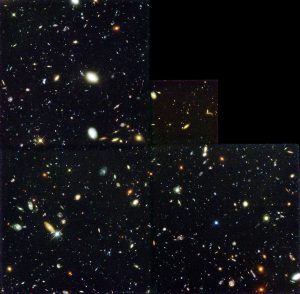
In the November/December 2015 edition of StarDate Magazine, I quote Merlin as follows, “Astronomers see the earliest galaxies as they looked about 13 billion years ago. Since the time when those galaxies emitted the light that astronomers now detect, though, space itself has expanded, so the galaxies are now 48 billion light-years away.”
If those galaxies are moving away from Earth at nearly the speed of light, you would expect they could only be about 26 billion light-years from Earth when we detected their light of 13 billion years ago. So, those galaxies moved at least an ADDITIONAL 22 billion light-years away in the 13 billion years it took their light to reach us. Is space expanding 1.7 times (or more) the speed of light? I thought the expansion of space itself only exceeded the speed of light during inflation at the very beginnings of the big bang.
This is a really good question, and one that a lot of people – including professional astronomers – have a hard time wrapping their head around.
The quick answer is yes, the Universe appears to be expanding faster than the speed of light. By which we mean that if we measure how quickly the most distant galaxies appear to be moving away from us, that recession velocity exceeds the speed of light.
However, it’s not really that simple, because the expansion of the Universe does not have a “speed.” The confusion stems from the fact that we know the Universe is expanding because of measurements of the velocity of galaxies. When Hubble did this in 1929, he found that almost all galaxies seem to be moving away from us, and that the most distant ones are moving the fastest, a result that has since been confirmed with better data.
To understand why this implies that the Universe is expanding, you can picture the Universe as the surface of a balloon covered in dots. As the balloon inflates, each dot moves away from every other dot, and the further apart two dots were to begin with, the faster they appear to move away from each other. However, the dots themselves are not actually moving, it’s the space in between them that gets larger. The folks at the Chandra X-ray Observatory have a cool animation of this: http://chandra.harvard.edu/photo/2004/darkenergy/accel_expanding_univ_lg.mov [22.6MB].
Similarly, what we measure as velocity in galaxies is not actually the galaxies moving, it’s the space in between them getting larger. There’s nothing actually traveling faster than light, hence Einstein’s theory of relativity – which tells us nothing can move faster than light – is not being violated.
I hope this helps but do feel free to get in touch if you have any further questions!
Dr. Rachael Livermore
UT Austin